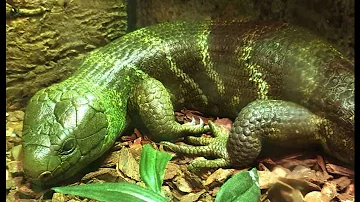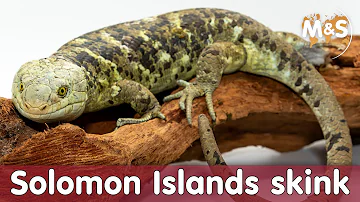
Solomon Island Skink
Corucia zebrata

Meet the Solomon Island Skink
The Solomon Island Skink, also known as the prehensile-tailed skink or monkey-tailed skink, is the largest known species of skink in the world. Native exclusively to the Solomon Islands, this reptile is famous for its strong, prehensile tail and unique social structure, often living in family groups called circuli. It is a slow-moving, arboreal lizard adapted for life among the dense foliage of rainforest canopies, and exhibits striking green to olive coloration that provides excellent camouflage. Their slow, deliberate movements and gentle dispositions make them unique among lizards, and they are the only known truly social skink species.
Classification
Reptile
Habitat
Tropical rainforest canopy
Diet
Herbivore
Lifespan
15-25 years
Conservation
Near Threatened
Weight
400-600 grams
📖Fascinating Facts
Arboreal Lifestyle
The Solomon Island Skink spends almost its entire life in the forest canopy, using its prehensile tail to move gracefully among branches.
Social Structure
Unlike most reptiles, this skink forms cooperative social groups called circuli, where adults help protect and care for young skinks.
Strict Herbivore
Their diet consists almost entirely of leaves, flowers, and fruit, making them one of the few strictly herbivorous lizards.
📋Detailed Description
The Solomon Island Skink (Corucia zebrata) is a robust, arboreal lizard reaching lengths of up to 80 cm (31 in), making it the largest extant skink species. Its body is heavily built, with strong limbs and large, overlapping scales that range in color from bright green to olive, often mottled with darker patches for camouflage among the rainforest canopy. The most distinctive feature is its long, muscular, fully prehensile tail, which it uses as a fifth limb to grasp branches and stabilize itself while climbing. Unlike most skinks, Corucia zebrata exhibits complex social behavior, living in stable family groups called circuli, which may include multiple generations and unrelated individuals. These skinks are primarily folivorous, feeding on a wide variety of leaves, flowers, and fruits, and possess specialized teeth and a large cecum for fermenting fibrous plant material. They are slow-moving and largely nocturnal or crepuscular, relying on stealth and camouflage rather than speed to avoid predators. Reproduction is viviparous, with females giving birth to a single, large, fully developed offspring after a gestation period of 6–8 months. Parental care is pronounced, with both parents and group members protecting and sometimes feeding the young. Their gentle disposition and unique sociality set them apart from other lizards, and they are considered a flagship species for the conservation of the Solomon Islands' rainforest canopy.
💡 Did you know?
Unlike most lizards, the Solomon Island Skink is a strict herbivore, feeding almost exclusively on leaves and fruits from specific tree species.
🔬Research & Sources
🎭Behavior & Social Structure
Solomon Island Skinks are primarily arboreal and spend most of their lives in the upper canopy, rarely descending to the ground. They are folivores, feeding slowly and methodically on leaves, shoots, flowers, and occasionally fruits from a variety of native plant species, including Epipremnum and Hibiscus. Foraging typically occurs during twilight or nighttime hours, minimizing exposure to predators. Social interactions are highly developed; individuals recognize group members by scent and engage in mutual grooming, coordinated movement, and communal defense against intruders. Aggression within groups is rare but can occur during resource scarcity or breeding. Daily routines involve basking in filtered sunlight, slow foraging, and resting in dense foliage or tree hollows. Vocalizations and body language, such as tail curling and head bobbing, are used for communication within the circulus.
👶Reproduction & Life Cycle
Corucia zebrata is unique among skinks for its viviparous reproduction, giving birth to live young rather than laying eggs. Mating typically occurs during the wet season, with courtship involving gentle nuzzling and following behavior. Females undergo a lengthy gestation period of 6–8 months, after which they give birth to a single, exceptionally large neonate (up to 35% of the mother's body length). The young are precocial but remain with the family group, receiving protection and sometimes regurgitated food from adults. Breeding frequency is low, with females reproducing only once every one to two years, contributing to slow population growth. Parental care is extensive, with both parents and other group members participating in defense and social integration of the young.
🛡️Adaptations & Survival
The Solomon Island Skink exhibits several unique adaptations for arboreal life and herbivory. Its prehensile tail acts as a fifth limb, allowing secure movement among branches and providing stability while feeding. The robust, clawed limbs facilitate climbing and gripping. Specialized, laterally compressed teeth and a large cecum enable efficient processing of tough, fibrous plant material through hindgut fermentation. Their cryptic coloration and slow, deliberate movements minimize detection by predators. Social living in circuli provides collective vigilance and defense, an unusual trait among reptiles. Additionally, their low metabolic rate and ability to subsist on nutrient-poor foliage are key evolutionary specializations for survival in the rainforest canopy.
📚Research Sources
🎨Cultural Significance
While not widely featured in traditional Solomon Islander folklore, the skink is sometimes regarded as a symbol of the unique biodiversity of the islands. In recent years, it has become a flagship species for conservation education and ecotourism, raising awareness about the importance of preserving the archipelago's rainforests. There are no known traditional uses for the skink, but its presence in the international pet trade has increased its profile among reptile enthusiasts worldwide.
🔬Recent Research & Discoveries
Recent studies have focused on the skink's social structure, revealing complex group dynamics and cooperative behaviors rare among reptiles. Genetic research has identified significant population structuring across different islands, suggesting limited dispersal and highlighting the need for localized conservation strategies. Investigations into their gut microbiome have provided insights into their adaptation to a folivorous diet. Ongoing research is examining the impact of habitat fragmentation on genetic diversity and reproductive success. Captive breeding programs are being developed to support population recovery and reduce pressure from illegal collection.
🎥Wildlife Videos

Solomon Island Skink
This guy was going through shed, but still an amazing lizard! He was so docile and easy to handle. I really enjoy learning about ...
Animal Education with Cole Shirk

#NHMLA Lunch Time with Live Animals | Tallulah the Skink!
Put on your nature eyes and get to know Tallulah, the Solomon Islands skink! From her prehensile tail to her tiny sharp teeth, ...
Natural History Museum of Los Angeles County (NHM)

The Secret Lives of Solomon Island Reptiles #animal2024 #wildlife
The Secret Lives of Solomon Island Reptiles Uncover the fascinating hidden world of reptiles in the Solomon Islands, where ...
CuteAnimal_JC

Solomon island skink
Skink or swim on this quiz How long can the Solomon island skink grow? What is the most notable visual difference between male ...
Seths search for species Evolution to extinction

Solomon Islands' Prehensile-tailed Skink in Slow Motion
Meet Dash the Monkey-Tailed Skink at SeaWorld Orlando! Dash is an endangered Prehensile-tailed skink who's species comes ...
FunLife Travel

Solomon Islands skink (Corucia zebrata) 🏝️
Today's episode is about the prehensile-tailed skink (Corucia zebrata). The animals live on the Solomon Islands and have a ...
ReptilTV English
🌍Habitat Information
The Solomon Island Skink typically inhabits Tropical rainforest canopy environments. Solomon Island Skinks have adapted to their environments with specialized features and behaviors.
Primary Habitat:
Tropical rainforest canopy
More detailed habitat information will be available soon.
🛡️Conservation Status
The Solomon Island Skink is currently classified as Near Threatened. Conservation efforts are crucial for preserving this species for future generations.
Common Threats:
- 🏠Habitat loss and fragmentation
- 🌡️Climate change impacts
- 🎯Hunting and poaching
- 🏭Human-wildlife conflict
⚠️Threats & Conservation Challenges
Major threats to Corucia zebrata include habitat loss due to logging, agricultural expansion, and mining in the Solomon Islands, which fragment and degrade their rainforest habitat. The species is also targeted by the illegal pet trade, as its rarity and unique behavior make it highly sought after. Slow reproductive rates and high juvenile mortality further exacerbate population declines. Climate change poses additional risks by altering forest composition and microclimates. Conservation challenges include enforcing wildlife protection laws, managing habitat reserves, and promoting sustainable livelihoods for local communities. Population trends are declining, and the species is classified as Near Threatened by the IUCN.
🔬Scientific Classification
Scientific Name
Corucia zebrata
Classification Hierarchy
🔍 About Taxonomic Classification
Taxonomic classification is a hierarchical system used by scientists to classify and organize living organisms based on shared characteristics and evolutionary relationships.
The system moves from broad categories (Kingdom) to increasingly specific ones, with each animal's scientific name typically consisting of its Genus and species.
📝Community Notes
Share your observations and insights about the Solomon Island Skink with our community of wildlife enthusiasts.
Join Our Community
Sign in to share your observations and connect with fellow wildlife enthusiasts.
Sign In to ContributeNo community notes yet
Be the first to share your observations about the Solomon Island Skink!
Explore Solomon Island Skink
Select a tab above to learn more about this amazing animal.
📸Photo Gallery
No photos available for this animal yet.
🌟Discover More Wildlife
Continue your journey of discovery with more fascinating animals from our database
